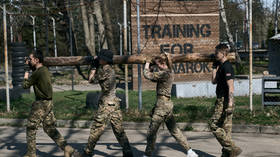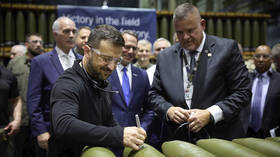Kiev may have to accept loss of territory – Stoltenberg
Ukraine could end up sacrificing land in order to end the conflict with Russia, the former NATO chief has said
Ukraine may have to recognize the loss of some of its territory to Russia in order to achieve peace and security guarantees, Jens Stoltenberg said in his first long interview after stepping down as NATO secretary-general.
Stoltenberg ended his ten-year tenure as the chief of the US-led alliance on October 1. In a conversation with the Financial Times published on Friday, he said that Kiev may be forced to rethink seeing the restoration of the 1991 borders as a prerequisite for any peace deal.
Stoltenberg suggested that “a kind of new momentum” would come after the US presidential election in early November, possibly ushering in “ways to try to get movement on the battlefield combined with movement around the negotiating table.”
The West should “make the conditions” that would enable Ukraine to “sit down with the Russians and get something which is acceptable… something where they survive as an independent nation.”
Asked what he would propose to Ukrainian leader Vladimir Zelensky, the former NATO chief offered a comparison to the resolution of the Soviet-Finnish war nearly 85 years ago.
“Finland fought a brave war against the Soviet Union in ‘39. They imposed much bigger costs on the Red Army than expected,” he said. “The war ended with them giving up 10% of the territory. But they got a secure border.”
Under the March 1940 treaty, Finland ceded a large portion of the Karelia region and Viipuri, its second-largest city at the time (known as Vyborg in Russia).
Stoltenberg argued that Ukraine could obtain security guarantees from NATO even “if there is a line that is not necessarily the internationally recognized border.” He noted that the US defense pact with Japan does not cover Tokyo’s claim on the Kuril Islands, which are part of Russia, and that West Germany was admitted to NATO despite the fact that East Germany was controlled at the time by a separate, Soviet-aligned government.
“When there is a will, there are ways to find the solution. But you need a line which defines where Article 5 is invoked, and Ukraine has to control all the territory until that border,” Stoltenberg said, referring to the section of the NATO treaty, which outlines the duty of member states to defend each other.
Russia has said that it would not accept Zelensky’s ten-point ‘peace formula’ and not relinquish control over Crimea and four other regions, which Kiev and its backers continue to view as Ukrainian territory under illegal occupation.
Kiev’s hopes of imposing its terms appear more distant after the failed 2023 counteroffensive and Russia’s new victories in Donbass, where Moscow’s troops have been making steady progress throughout 2024. During its renewed advances, the Russian Army pushed the Ukrainians out of several heavily fortified towns, including Avdeevka, which fell in February, and Ugledar, which was captured earlier this week.







Comments are closed.